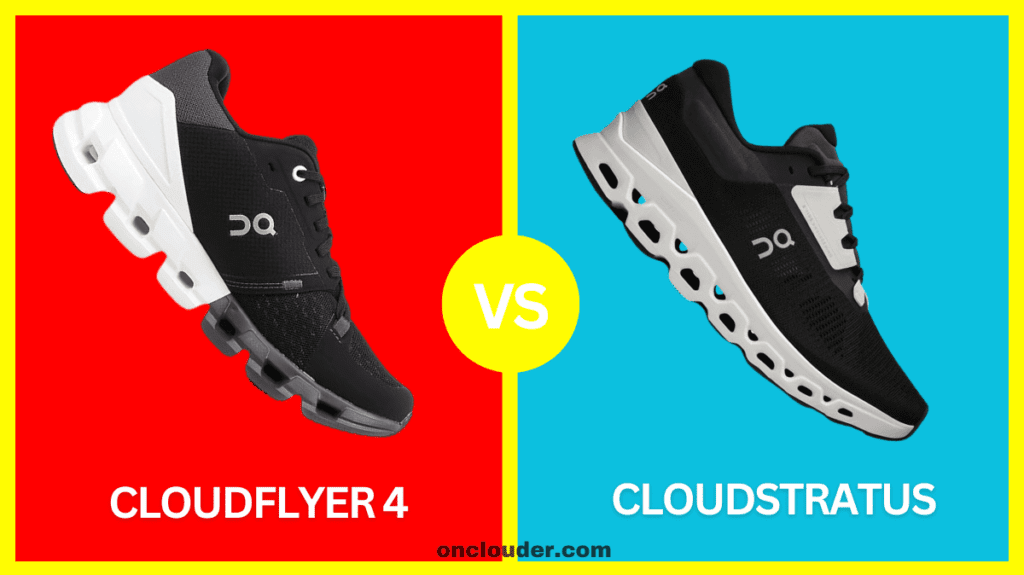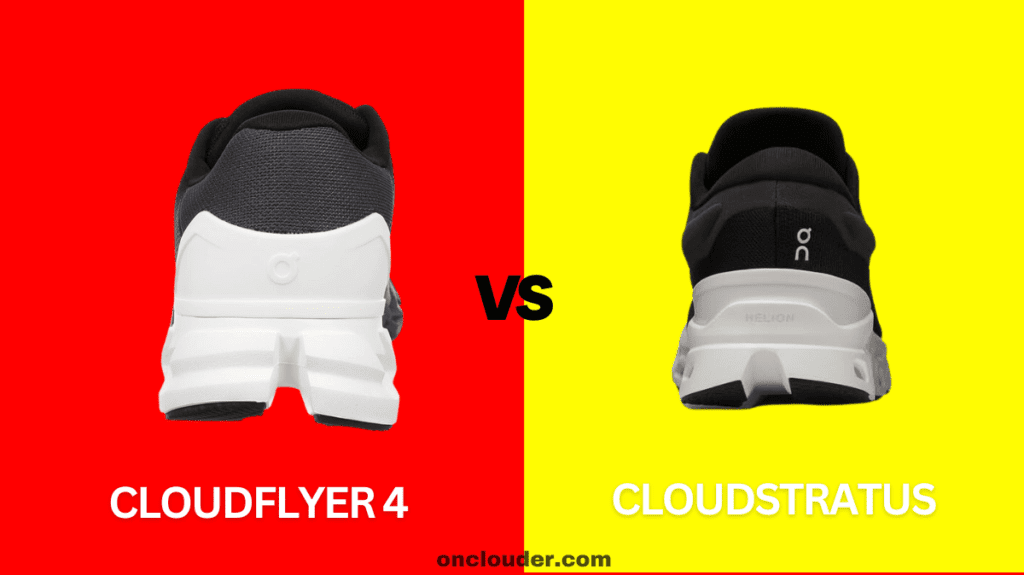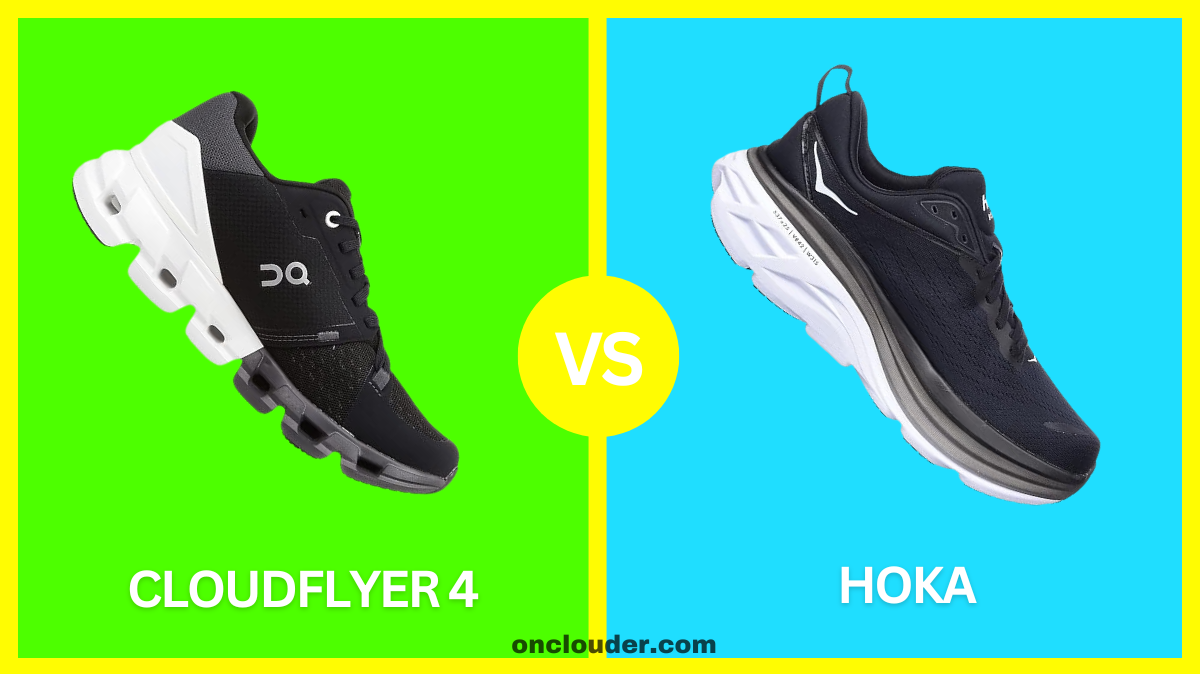Hey there, young runners! Are you looking for a new pair of shoes to help you zoom around the track or cruise through your neighborhood?
Well, you’re in luck because today we’re going to talk about two awesome running shoes: the Cloudflyer 4 and the Cloudstratus. These shoes are made by a cool company called On Running, and they’re both great choices for different reasons.
Let’s dive in and see which one might be perfect for you!

Contents
- 1 Quick Comparison: Cloudflyer 4 vs Cloudstratus Shoes
- 2 What Makes These Shoes Special?
- 3 Comfort: Walking on Clouds
- 4 Fit: Finding Your Perfect Match
- 5 Stability: Keeping You Steady
- 6 Durability: Built to Last
- 7 Breathability: Keeping Your Feet Cool
- 8 Weight: Light as a Feather?
- 9 Flexibility: Bend and Flex
- 10 Water Resistance: Splish Splash
- 11 Sole: Where the Rubber Meets the Road
- 12 Style: Looking Good While You Run
- 13 User Reviews: What Do Other Runners Think?
- 14 Price: What’s It Gonna Cost?
- 15 Conclusion
- 16 Frequently Asked Questions
Quick Comparison: Cloudflyer 4 vs Cloudstratus Shoes
The main difference between Cloudflyer 4 and Cloudstratus shoes is their support level. Cloudflyer 4 offers moderate support for overpronators, while Cloudstratus provides maximum support for runners needing extra stability. Cloudflyer 4 is lighter and more flexible, ideal for everyday runs. Cloudstratus has more cushioning, making it better for long distances.
Now, let’s create a detailed comparison table for Cloudflyer 4 vs Cloudstratus shoes:
| Feature | Cloudflyer 4 | Cloudstratus |
| Support Level | Moderate | Maximum |
| Weight | Lighter (about 280g) | Heavier (about 305g) |
| Cushioning | Medium | High |
| Best Use | Everyday runs, shorter distances | Long-distance runs |
| Pronation Control | Mild to moderate overpronation | Severe overpronation |
| Flexibility | More flexible | Less flexible |
| Heel-to-Toe Drop | 9mm | 8mm |
| Upper Material | Engineered mesh | Engineered mesh |
| Midsole Technology | Helion superfoam | Helion superfoam |
| Price | Slightly less expensive | Slightly more expensive |
In summary: Cloudflyer 4 and Cloudstratus are both running shoes made by On, but they have some differences. Cloudflyer 4 is lighter and better for everyday runs. It helps a little if your feet roll inward when you run.
Cloudstratus is heavier but has more cushioning. It’s great for long runs and helps a lot if your feet roll inward too much. Cloudflyer 4 bends more easily, while Cloudstratus gives more support. Both shoes have special foam to make running comfy. Choose Cloudflyer 4 for shorter runs and Cloudstratus for longer ones.
Also Read: Cloudflyer 4 vs Cloudswift
What Makes These Shoes Special?
Before we get into the nitty-gritty details, let’s talk about what makes these shoes stand out. Both the Cloudflyer 4 and the Cloudstratus are designed to give you a comfy ride while you run.
They use special technology to help cushion your feet and make you feel like you’re running on clouds (hence the “Cloud” in their names!).
Comfort: Walking on Clouds
Cloudflyer 4: Soft and Bouncy
The Cloudflyer 4 is like having little trampolines under your feet. It’s super soft and bouncy, which means it’s great for long runs or if you have sore feet. The shoe has lots of cushioning, especially in the heel, so when your foot hits the ground, it feels nice and gentle.
Cloudstratus: Double the Cushion
Now, the Cloudstratus takes cushioning to a whole new level. It has not one, but two layers of cloud-like cushioning! This means it’s extra soft and comfy, perfect for runners who want the most cushion possible. It’s like running on a fluffy cloud mattress!
Fit: Finding Your Perfect Match
Getting the right fit is super important when you’re choosing running shoes. Let’s see how these two stack up:
Cloudflyer 4: Snug and Secure
The Cloudflyer 4 has a fit that’s snug but not too tight. It hugs your foot in all the right places, which helps prevent your foot from sliding around inside the shoe. This is great for keeping your feet stable when you’re running.
Cloudstratus: Roomy and Comfortable
The Cloudstratus has a bit more room in the toe box (that’s the part where your toes go). This extra space can be really nice if your feet tend to swell up during long runs or if you just like having some wiggle room for your toes.
Stability: Keeping You Steady
When you’re running, you want shoes that help you stay balanced and prevent wobbling. Both of these shoes do a good job at this, but in slightly different ways.
Cloudflyer 4: Extra Support
The Cloudflyer 4 is designed with extra support features. It has a wider base and special cushioning pods that help keep your foot in the right position. This is awesome if you tend to roll your foot inward when you run (which is called overpronation).
Cloudstratus: Balanced and Smooth
The Cloudstratus also provides good stability, but in a more subtle way. Its double layer of cushioning helps distribute your weight evenly across your foot, which can help you maintain good form as you run.

Durability: Built to Last
You want your running shoes to last a long time, right? Let’s see how these shoes hold up over time.
Cloudflyer 4: Tough and Resilient
The Cloudflyer 4 is built with strong materials that can handle lots of miles. The rubber on the bottom of the shoe (called the outsole) is extra durable, so it won’t wear down quickly even if you run on rough surfaces.
Cloudstratus: Long-Lasting Comfort
The Cloudstratus is also made to last. Its double layer of cushioning not only provides comfort but also helps the shoe maintain its shape and support over time. The upper part of the shoe (the part that covers your foot) is made of a tough material that resists tears and stretching.
Also Read: Cloudflyer 4 vs Cloudsurfer
Breathability: Keeping Your Feet Cool
Nobody likes sweaty, stinky feet! Let’s see how these shoes help keep your feet fresh and dry.
Cloudflyer 4: Light and Airy
The Cloudflyer 4 has a mesh upper that allows air to flow through the shoe. This helps keep your feet cool and dry, even on hot days or during long runs.
Cloudstratus: Ventilated Comfort
The Cloudstratus also features a breathable upper, with strategic ventilation zones to let hot air escape and cool air enter. This helps prevent your feet from overheating during intense workouts.
Weight: Light as a Feather?
The weight of your running shoes can make a big difference in how you feel during your run. Let’s compare these two:
| Shoe Model | Average Weight (Men’s) | Average Weight (Women’s) |
| Cloudflyer 4 | 10.2 oz (289g) | 8.5 oz (241g) |
| Cloudstratus | 10.7 oz (303g) | 9.1 oz (258g) |
As you can see, the Cloudflyer 4 is slightly lighter than the Cloudstratus. This might not seem like a big difference, but over many steps, it can add up!
Flexibility: Bend and Flex
Running shoes need to be flexible so they can move with your foot. Let’s see how these shoes flex:
Cloudflyer 4: Responsive Flex
The Cloudflyer 4 has a good balance of flexibility and support. It bends easily at the front of the foot, which helps you push off the ground with each step.
Cloudstratus: Adaptive Movement
The Cloudstratus is designed to flex with your foot’s natural movement. Its unique cushioning system allows the shoe to adapt to your stride, providing flexibility where you need it most.

Water Resistance: Splish Splash
While these shoes aren’t meant for swimming, it’s good to know how they handle a little water.
Cloudflyer 4: Quick-Drying
The Cloudflyer 4 isn’t waterproof, but its mesh upper dries quickly if you happen to run through a puddle or get caught in a light rain.
Cloudstratus: Water-Ready
The Cloudstratus has similar properties, with materials that don’t absorb much water and dry out fast. This helps keep your feet comfortable even in damp conditions.
Sole: Where the Rubber Meets the Road
The sole of a running shoe is super important. It’s the part that actually touches the ground and helps propel you forward.
Cloudflyer 4: Grippy and Responsive
The Cloudflyer 4 has a sole with lots of little “cloud” pods. These pods compress when your foot hits the ground and then spring back, giving you a bouncy feel. The rubber on the bottom provides good grip on different surfaces.
Cloudstratus: Double the Fun
The Cloudstratus has a unique sole with two layers of cloud pods. This gives you extra cushioning and a smooth ride. The rubber on the bottom is designed to last a long time and give you good traction.

Style: Looking Good While You Run
Let’s face it, we all want shoes that look cool too! Here’s how these shoes stack up in the style department:
Cloudflyer 4: Sleek and Modern
The Cloudflyer 4 has a sleek, modern look with clean lines and cool color options. It looks fast even when you’re standing still!
Cloudstratus: Bold and Eye-Catching
The Cloudstratus has a more pronounced sole design that really stands out. It comes in some fun color combinations that are sure to get noticed on the track or trail.
Also Read: Cloudflyer 4 vs Cloud X 3
User Reviews: What Do Other Runners Think?
It’s always good to hear what other people think about these shoes. Here’s a summary of user reviews:
| Shoe Model | Overall Rating | Comfort | Durability | Style |
| Cloudflyer 4 | ⭐⭐⭐⭐½ | ⭐⭐⭐⭐⭐ | ⭐⭐⭐⭐ | ⭐⭐⭐⭐ |
| Cloudstratus | ⭐⭐⭐⭐ | ⭐⭐⭐⭐⭐ | ⭐⭐⭐⭐ | ⭐⭐⭐½ |
As you can see, both shoes are highly rated, with the Cloudflyer 4 getting a slightly higher overall score.
Price: What’s It Gonna Cost?
Running shoes can be a big investment, so it’s important to know what you’re getting into. Here’s a comparison of the prices:
| Shoe Model | Average Price Range |
| Cloudflyer 4 | $160 – $180 |
| Cloudstratus | $170 – $190 |
The Cloudstratus is usually a bit more expensive, likely due to its double layer of cushioning.
Pros and Cons
| Shoe | Pros ✅ | Cons ⚠️ |
| Cloudflyer 4 | Lighter weight, easy to run in | Less cushioning for long runs |
| More flexible, bends easily | Not enough support for very flat feet | |
| Good for everyday runs | Might wear out faster on rough roads | |
| Slightly cheaper | Not ideal for very long distances | |
| Cloudstratus | 1More cushioning, comfy for long runs | Heavier, might feel clunky |
| Great support for flat feet | Less flexible, might feel stiff | |
| Durable, lasts longer | Can be too much shoe for short runs | |
| Good for bigger runners | Slightly more expensive |
Conclusion
After looking at all these details, you might be wondering which shoe is the best choice. The truth is, both the Cloudflyer 4 and the Cloudstratus are great shoes, but they might be better for different types of runners.
Choose the Cloudflyer 4 if:
- You want a lighter shoe
- You need extra stability support
- You prefer a snugger fit
Go for the Cloudstratus if:
- You want maximum cushioning
- You like a roomier toe box
- You’re okay with a slightly heavier shoe for more comfort
Remember, the best shoe for you is the one that feels most comfortable when you run. If possible, try both shoes on and take them for a short jog around the store. Your feet will tell you which one they like best!
Frequently Asked Questions
Are these shoes good for beginners?
Yes! Both the Cloudflyer 4 and Cloudstratus are great for beginners. They offer lots of cushioning and support, which can help new runners feel more comfortable as they start their running journey.
Can I use these shoes for other sports?
While these shoes are designed primarily for running, they can be used for other activities like walking or light gym workouts. However, for sports that require quick side-to-side movements, you might want to look for a shoe specifically designed for that sport.
How long do these shoes usually last?
With regular use, these shoes typically last between 400-500 miles. This could be anywhere from 6 months to a year, depending on how often and how far you run.
Do I need to break in these shoes?
Both the Cloudflyer 4 and Cloudstratus are designed to be comfortable right out of the box. However, it’s always a good idea to start with shorter runs to let your feet get used to the new shoes before going on long runs.
Are these shoes good for people with flat feet?
Yes, both shoes offer good support for people with flat feet. The Cloudflyer 4, in particular, has extra stability features that can be helpful for flat-footed runners.




